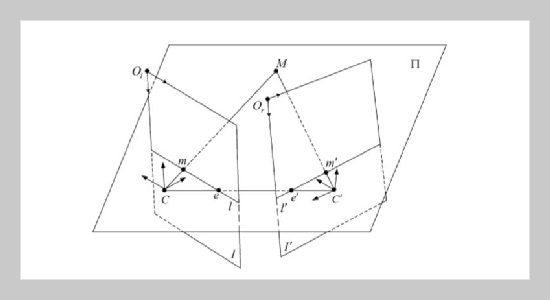REFERENCES
- [1] Chaumette, F., and S. Hutchinson (2007) Visual servo control, part II: Advanced approaches, IEEE Robotics and Automation Magazine 14(1), 109�118. doi: 10. 1109/MRA.2007.339609
- [2] Sebastián, J. M., L. Pari, L. Angel, and A. Traslosheros (2009) Uncalibrated visual servoing using the fundamental matrix, Robotics and Autonomous Systems 57(1), 1�10. doi: 10.1016/j.robot.2008.04.002
- [3] Liang, X., H. Wang, W. Chen, D. Guo, and T. Liu (2015) Adaptive image-based trajectory tracking control of wheeled mobile robots with an uncalibrated fixed camera, IEEE Transactions on Control Systems Technology 23(6), 2266�2282. doi: 10.1109/TCST. 2015.2411627
- [4] Li, B., Y. Fang, and X. Zhang (2016) Visual servo regulation of wheeled mobile robots with an uncalibrated onboard camera, IEEE/ASME Transactions on Mechatronics 21(5), 2330�2342. doi: 10.1109/TMECH. 2015.2504098
- [5] Fischler, M. A., and R. C. Bolles (1981) Random sample consensus: a paradigm for model fitting with applications to image analysis and automated cartography, Communications of the ACM 24(6), 381�395.
- [6] Zhang, Z. (1998) Determining the epipolar geometry and its uncertainty: a review, International Journal of Computer Vision 27(2), 161�195. doi: 10.1023/A: 1007941100561
- [7] Hartley, R. (1997) In defense of the eight-point algorithm, IEEE Transactions on Pattern Analysis and Machine Intelligence 19(6), 580�593. doi: 10.1109/ 34.601246
- [8] Chesi, G., A. Garulli, A. Vicino, and R. Cipolla (2002) Estimating the fundamental matrix via constrained least-squares: a convex approach, IEEE Transactions on Pattern Analysis and Machine Intelligence 24(3), 397�401. doi: 10.1109/CVPR.2013.203
- [9] Zheng, Y., S. Sugimoto, and M. Okutomi (2013) A practical rank-constrained eight-point algorithm for fundamental matrix estimation, Proc. of IEEE Conference on Computer Vision and Pattern Recognition, Portland, USA, Jun. 23�28, 1546�1553. doi: 10.1109/34.990139
- [10] Bugarin, F., A. Bartoli, D. Henrion, J. B. Lasserre, J. J. Orteu, and T. Sentenac (2015) Rank-constrained fundamental matrix estimation by polynomial global optimization versus the eight-point algorithm, Journal of Mathematical Imaging and Vision 53(1), 42�60. doi: 10.1007/s10851-014-0545-9
- [11] Kanatani, K., and Y. Sugaya (2007) High accuracy fundamental matrix computation and its performance evaluation, IEICE TRANSACTIONS on Information and Systems E90D(2), 579�585. doi: 10.1093/ietisy/ e90-d.2.579
- [12] Sugaya, Y., and K. Kanatani (2007) High accuracy computation of rank-constrained fundamental matrix, Proc. of British Machine Vision Conference, Coventry, UK, Sep. 10�13, 1�10. doi: 10.5244/C.21.19
- [13] Zheng, Y., S. Sugimoto, and M. Okutomi (2011) A branch and contract algorithm for globally optimal fundamental matrix estimation, Proc. of IEEE Conference on Computer Vision and Pattern Recognition, Colorado Springs, USA, Jun. 20�25, 2953�2960. doi: 10.1109/CVPR.2011.5995352
- [14] Hartley, R. and A. Zisserman (2004) Multiple View Geometry in Computer Vision, 2nd ed., Cambridge University Press, Cambrige, 284�288.
- [15] Migita, T. and T. Shakunaga (2007) Evaluation of epipole estimation methods with/without rank-2 constraint across algebraic/geometric error functions, Proc. of IEEE Conference on Computer Vision and Pattern Recognition,Minneapolis,USA, Jun. 17�22, 1�7.doi: 10.1109/CVPR.2007.383116
- [16] Tanabe, K. (1980) A geometric method in nonlinear programming, Journal of Optimization Theory and Applications 30(2), 181�210. doi: 10.1007/BF00934495
- [17] Brown, A. A., and M. C. Bartholomew-Biggs (1989) ODE versus SQP methods for constrained optimization, Journal of Optimization Theory and Applications 62(3), 371�386. doi: 10.1007/BF00939812
- [18] Absi, P. A. (2005) Computation with continuous-time dynamical systems, Proc. of the Grand Challenge in Non-Classical Computation International Workshop, York, UK. Apr. 18�19, 5�7.
- [19] Quan, Q., and K. Y. Cai (2016) A new continuous-time equality-constrained optimization to avoid singularity, IEEE Transactions on Neural Networks and Learning Systems 27(2), 262�272. doi: 10.1109/TNNLS.2015. 2476348
- [20] Armangué, X., and J. Salvi (2003) Overall view regarding fundamental matrix estimation, Image and Vision Computing 21(2), 205�220. doi: 10.1016/ S02628856(02)00154-3
- [21] Lowe, D. G. (2004) Distinctive image features from scale-invariant keypoints, International Journal of Computer Vision 60(2), 91�110. doi: 10.1023/B:VISI. 0000029664.99615.94
















